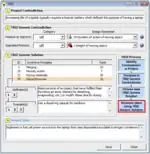SDI Tools
SDI Tools is a set of commercial software add-in tools for Microsoft Excel developed and distributed by Statistical Design Institute, LLC., a privately owned company located in Texas, United States.
 | |
 SDI Tools: TRIZ Tool Interface | |
| Developer(s) | Statistical Design Institute, LLC |
|---|---|
| Stable release | 4.11
/ Sep-2018 |
| Operating system | Windows |
| Type | Statistical analysis |
| License | proprietary |
| Website | www.stat-design.com |
SDI Tools were first developed in 2000 by Dr. George Chollar, Dr. Jesse Peplinski, and Garron Morris as several Add-Ins for Microsoft Excel to support a methodology for product development that combined elements of Design for Six Sigma and Systems Engineering[1][2]
Today, SDI Tools are split into two main Microsoft Excel Add-Ins called Triptych and Apogee.
Triptych
Triptych is a Microsoft Excel Add-in that provides support for documenting and clarifying the voice of the customer (VOC), identifying and flowing down requirements, and generating and selecting design alternatives. Triptych includes functionality for:
- QFD: Captures the voice of the customer and translates it into engineering requirements using Quality Function Deployment methods.
- Affinity Diagram: A Tool for sorting large number of ideas or concepts into logical groupings using the Affinity diagram method.
- AHP (Importance): Prioritizes (or ranks) Items by performing pair-wise comparisons of Items against each other in terms of relative importance using a one-level Analytic Hierarchy Process.
- TRIZ: Generates ideas for solving technical contradictions using the Theory of Inventive Problem Solving TRIZ.
- Pugh Matrix: Qualitative multi-criteria decision analysis using Pugh Concept Selection method.
- TOPSIS: Goal-based multi-criteria decision analysis using Technique for Order Preference by Similarity to Ideal Solution (TOPSIS) methodology.
- SDI Matrix: Quantitative multi-criteria decision analysis developed by Statistical Design Institute using Value Assessments for product specifications.
- FMEA: A risk assessment technique for systematically identifying potential failures in a system or a process using Failure mode and effects analysis.
Apogee
Apogee is a Microsoft Excel Add-In that integrates the capabilities of sensitivity analysis, Monte Carlo analysis, allocation, and multi-objective optimization into a single easy-to-use toolset. Apogee works with functions Y = f(x) that you create freeform in Microsoft Excel workbooks. Its functionality includes:
- Sensitivity Analysis: Assesses the magnitude of response variation caused by the variation of the parameters using a Sensitivity analysis.
- Monte Carlo Analysis: Assesses the magnitude and shape of response variation caused by the variation of the parameters using the Monte Carlo method.
- Allocation: identifies the allowable amount of parameter variation that will improve response variation to a desired level. (Often referred to as statistical tolerance analysis or requirements flowdown.)
- Optimization: searches for new parameter values that will drive multiple response values to desired targets using statistical, multi-objective optimization driven by a custom genetic algorithm.
Application of SDI Tools
SDI Tools are typically used in Six Sigma training,[3][4] industry,[5][6][7][8] and academic research [9][10][11]
See also
References
- G. Chollar, "A Statistical-Analysis Approach for System Requirements Definition and Flowdown.", PhD Dissertation, Texas Tech University, May 2000
- T.W. Simpson, J.D. Peplinski, P. N. Koch and J.K. Allen, "Metamodels for Computer-based Engineering Design: Survey and recommendations", Engineering with Computers, Vol. 17, No. 2, pp. 129-150.
- G. W. Chollar, "Effective Tools for Requirements and Concept Development", Aero Engineering USA Conference, November 2010
- G. W. Chollar, "Effective Tools for Design Analysis and Multi-Objective Optimization", Aero Engineering USA Conference, November 2010
- B. Demczar and G. W. Chollar, "Getting Results From DFSS In Product Development At IBM", 11th Annual Design for Six Sigma Excelling in Product Development Conference, June 22–24, 2009
- J. Pica, M. Tracy, and G. W. Chollar, "Quality Function Deployment at Lockheed Martin MS2", The 20th Symposium on QFD (ISBN 1-889477-20-6)
- G. W. Chollar, G. K. Morris, and J. D. Peplinski, "Applying Systems Engineering and Design for Six Sigma in a Requirements-Based Cost Modeling Process", Proceedings of the 2008 Industrial Engineering Research Conference, J. Fowler and S. Mason, eds, 2008
- G. W. Chollar, "Effective Methods and Tools for Developing Specifications, Products, and Assessing Risk", 7th Lean Six Sigma for Pharmaceutical, Biotech, and Medical Device Excellence, February 2009
- G. C. Martin, "Constructing a Regional Adolescent Health and Wellness Index for British Columbia, Canada", M.S. Thesis, University of Victoria, 2008
- T. Woods, "System Engineering the Mission Critical Software Release Decision", PhD Dissertation, Southern Methodist University, December 2010
- P. Hart, “A PLM Implementation for Aerospace Systems Engineering-Conceptual Rotorcraft Design”, Master Thesis, Georgia Institute of Technology, May 2009